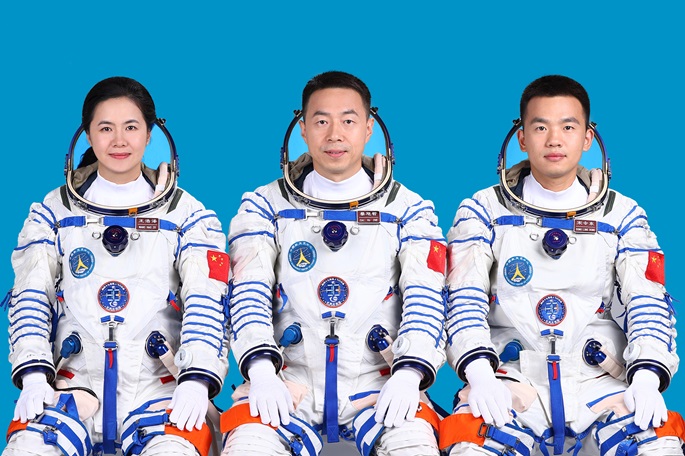Shenzhou-19 astronauts start journey to China's space station
Published : 30 Oct 2024, 01:29
China launched the Shenzhou-19 crewed spaceship on Wednesday, sending three astronauts -- including the country's first female space engineer -- to its orbiting space station for a six-month mission, reported Xinhua.
The spaceship, atop a Long March-2F carrier rocket, blasted off at 4:27 a.m. (Beijing Time) from the Jiuquan Satellite Launch Center in northwest China, said the China Manned Space Agency (CMSA).
About 10 minutes after the launch, the Shenzhou-19 spaceship separated from the rocket and entered its designated orbit. The crew members are in good shape and the launch is a complete success, the CMSA announced.
The spaceship will then perform a fast, automated rendezvous and docking with the front port of the space station core module Tianhe in about 6.5 hours, forming a combination of three modules and three spacecraft.
The Shenzhou-19 crew consists of mission commander Cai Xuzhe, and astronauts Song Lingdong and Wang Haoze.
Cai is a seasoned astronaut who previously journeyed into orbit on the Shenzhou-14 mission in 2022. With this ongoing mission, he set a new record for the shortest interval between two spaceflights for Chinese astronauts.
Song and Wang, part of the third batch of Chinese astronauts, are newcomers to space, both born in the 1990s.
Wang is currently China's only female space engineer and the third Chinese woman participating in a crewed spaceflight mission, the agency noted.
DIVERSE SCI-TECH TASKS
The new crew has numerous tasks ahead, including conducting space science and application tests, performing extravehicular activities, installing protective devices against space debris, and managing the installation and recycling of extravehicular payloads and equipment. They will also engage in science education, public interest activities, and other payload tests, Lin Xiqiang, CMSA spokesperson told a press conference on Tuesday.
They will carry out 86 space science research and technology experiments, covering various fields including space life science, microgravity fundamental physics, space material science, space medicine and new space technologies, Lin added.
The CMSA revealed in April that China had undertaken over 130 scientific research and application projects in its space station, while 300 scientific experiment samples had been brought back from space by manned missions in five batches.
In addition, more than 500 scientific research institutes worldwide had participated in these projects, achieving significant results in space life science, space medicine, space material science and microgravity fluid physics, with over 280 papers published in top international journals, the CMSA said.
The Shenzhou-19 astronauts will complete in-orbit rotation with the Shenzhou-18 trio and stay at the space station for approximately six months.
Cai Xuzhe told the press that he and the other two crew members have been training as a team for more than a year.
Multiple extravehicular activities are scheduled during the Shenzhou-19 mission. "We have conducted comprehensive ground training, considering all possible scenarios, learning from previous extravehicular activities and thoroughly preparing for every potential plan and contingency," Cai said.
Wang Haoze explained that she will be mainly responsible for space experimental projects, cargo management, and space station operation management.
UPGRADED TRANSPORT CAPABILITY
Researchers with the China Aerospace Science and Technology Corporation (CASC) have optimized the equipment and adjusted the layout within the orbital module of the spaceship to increase its loading capacity for the Shenzhou-19 space mission.
"Compared with Shenzhou-18, the payload space of Shenzhou-19 has been increased by 20 percent, making it possible to transport more time-sensitive and essential supplies for astronauts and related systems," said Chen Tongxiang, an expert with the CASC.
This not only allows for the transport of more scientific research equipment and supplies into space but also ensures more efficient and stable in-orbit support for the long-term operation of China's space station, she said.
China is also exploring ways to reduce the cargo transportation costs for its space station.
In 2023, a notice was issued to solicit overall schemes for the low-cost cargo transportation system. After two rounds of selection, schemes respectively from the Innovation Academy for Microsatellites of the Chinese Academy of Sciences and from the Chengdu Aircraft Design and Research Institute under the Aviation Industry Corporation of China finally won the contracts for the flight verification phase, Lin said.
The selection process has engaged scientific research institutes and commercial space companies in developing spacecraft, rockets and other flight products for China's manned space program, which will help reduce operating costs for the space station and foster the rapid, orderly and healthy development of the commercial space industry, he added.
EXCELLENT COOPERATION PLATFORM
China's space station boasts a wealth of scientific application resources and comprehensive support capabilities, and the Shenzhou manned system and Tianzhou cargo system can ensure reliable and stable round-trip transportation for personnel and supplies between Earth and the space.
"China's space station is an excellent platform for international collaboration," Lin said, noting that it serves not only as a national asset but also as a platform for advancing space technology and bringing benefits to all of humanity.
China has carried out international collaborations with major space-faring nations and developing countries across various areas, including astronaut selection and training, space science applications, in-orbit facilities, space debris protection and ground support, with abundant outcomes, Lin said.
Currently, the first batch of payloads selected through cooperation between China and the United Nations Office for Outer Space Affairs are undergoing experiments in orbit, Lin said, adding that more international collaborative research initiatives are in the pipeline.
China is also engaging in discussions to select and train astronauts from partner nations, inviting international counterparts to join its space station flight missions, Lin noted.
"No matter which country participates, it is humanity's collective quest to unravel the mysteries of the cosmos," said Lin.


